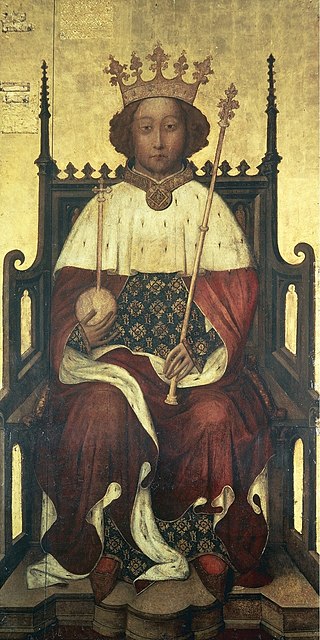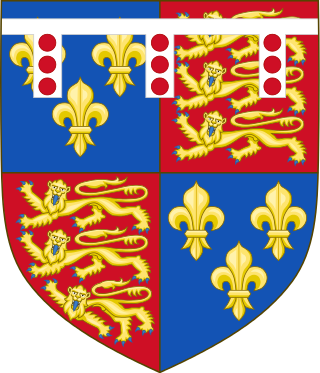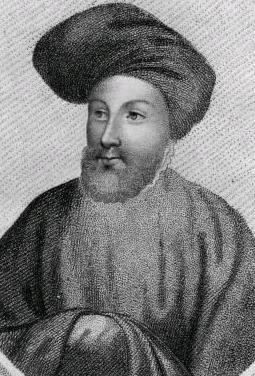Related Research Articles
1441 (MCDXLI) was a common year starting on Sunday of the Julian calendar, the 1441st year of the Common Era (CE) and Anno Domini (AD) designations, the 441st year of the 2nd millennium, the 41st year of the 15th century, and the 2nd year of the 1440s decade. As of the start of 1441, the Gregorian calendar was 9 days ahead of the Julian calendar, which was the dominant calendar of the time.

Richard II, also known as Richard of Bordeaux, was King of England from 1377 until he was deposed in 1399. He was the son of Edward, Prince of Wales, and Joan, Countess of Kent. Richard's father died in 1376, leaving Richard as heir apparent to his grandfather, King Edward III; upon the latter's death, the 10-year-old Richard succeeded to the throne.

Elizabeth Woodville, later known as Dame Elizabeth Grey, was Queen of England from her marriage to King Edward IV on 1 May 1464 until Edward was deposed on 3 October 1470, and again from Edward's resumption of the throne on 11 April 1471 until his death on 9 April 1483. She was a key figure in the Wars of the Roses, a dynastic civil war between the Lancastrian and the Yorkist factions between 1455 and 1487.

George Plantagenet, Duke of Clarence, was the sixth son of Richard Plantagenet, 3rd Duke of York, and Cecily Neville, and the brother of English kings Edward IV and Richard III. He played an important role in the dynastic struggle between rival factions of the Plantagenets now known as the Wars of the Roses.

The House of York was a cadet branch of the English royal House of Plantagenet. Three of its members became kings of England in the late 15th century. The House of York descended in the male line from Edmund of Langley, 1st Duke of York, the fourth surviving son of Edward III. In time, it also represented Edward III's senior line, when an heir of York married the heiress-descendant of Lionel, Duke of Clarence, Edward III's second surviving son. It is based on these descents that they claimed the English crown. Compared with its rival, the House of Lancaster, it had a superior claim to the throne of England according to cognatic primogeniture, but an inferior claim according to agnatic primogeniture. The reign of this dynasty ended with the death of Richard III of England at the Battle of Bosworth Field in 1485. It became extinct in the male line with the death of Edward Plantagenet, 17th Earl of Warwick, in 1499.

Edward, 2nd Duke of York, was an English nobleman, military commander and magnate. He was the eldest son of Edmund of Langley, 1st Duke of York, and a grandson of King Edward III of England. He held significant appointments during the reigns of Richard II, Henry IV, and Henry V, and is also known for his translation of the hunting treatise The Master of Game. He was killed in 1415 at the Battle of Agincourt, whilst commanding the right wing of the English army.

Thomas of Woodstock, Duke of Gloucester was the fifth surviving son and youngest child of King Edward III of England and Philippa of Hainault.

Humphrey of Lancaster, Duke of Gloucester was an English prince, soldier and literary patron. He was "son, brother and uncle of kings", being the fourth and youngest son of Henry IV of England, the brother of Henry V, and the uncle of Henry VI. Gloucester fought in the Hundred Years' War and acted as Lord Protector of England during the minority of his nephew. A controversial figure, he has been characterised as reckless, unprincipled, and fractious, but is also noted for his intellectual activity and for being the first significant English patron of humanism, in the context of the Renaissance.

John of Lancaster, Duke of Bedford KG was a medieval English prince, general and statesman who commanded England's armies in France during a critical phase of the Hundred Years' War. Bedford was the third son of King Henry IV of England, brother to Henry V, and acted as regent of France for his nephew Henry VI. Despite his military and administrative talent, the situation in France had severely deteriorated by the time of his death.
John Holland, 1st Duke of Exeter, 1st Earl of Huntingdon, KG, of Dartington Hall in Devon, was a half-brother of King Richard II (1377–1399), to whom he remained strongly loyal. He is primarily remembered for being suspected of assisting in the downfall of King Richard's uncle Thomas of Woodstock, 1st Duke of Gloucester (1355–1397) and then for conspiring against King Richard's first cousin and eventual deposer, Henry Bolingbroke, later King Henry IV (1399–1413).

The Lords Appellant were a group of nobles in the reign of King Richard II, who, in 1388, sought to impeach five of the King's favourites in order to restrain what was seen as tyrannical and capricious rule. The word appellant — still used in modern English by attorneys — simply means '[one who is] appealing'. It is the older (Norman) French form of the present participle of the verb appeler, the equivalent of the English 'to appeal'. The group was called the Lords Appellant because its members invoked a procedure under law to start prosecution of the King's unpopular favourites known as 'an appeal': the favourites were charged in a document called an "appeal of treason", a device borrowed from civil law which led to some procedural complications.

The Merciless Parliament was an English parliamentary session lasting from 3 February to 4 June 1388, at which many members of King Richard II's court were convicted of treason. The session was preceded by a period in which Richard's power was revoked and the kingdom placed under the regency of the Lords Appellant. Richard had launched an abortive military attempt to overthrow the Lords Appellant and negotiate peace with the kingdom of France so he could focus all his resources against his domestic enemies. The Lords Appellant counteracted the attempt and called the parliamentary session to expose his attempts to make peace. Parliament reacted with hostility and convicted almost all of Richard's advisers of treason. Most were executed and a few exiled. Parliament was dissolved after violence broke out in Kent and the Duke of York and his allies began objecting to some executions. The term "merciless" was coined by Augustinian chronicler Henry Knighton.

The Epiphany Rising was a failed rebellion against King Henry IV of England in early January 1400.

Eleanor Cobham was an English noblewoman, first the mistress and then the second wife of Humphrey, Duke of Gloucester, who in 1441 was forcibly divorced and sentenced to life imprisonment for treasonable necromancy, a punishment likely to have been politically motivated.

Henry le Despenser was an English nobleman and Bishop of Norwich whose reputation as the 'Fighting Bishop' was gained for his part in suppressing the Peasants' Revolt in East Anglia and in defeating the peasants at the Battle of North Walsham in the summer of 1381.
Events from the 1440s in England.
Thomas Cobham, de jure 5th Baron Cobham of Sterborough Castle, and from 1460 de jure 5th Baron Cobham, was an English nobleman.
Margery Jourdemayne, "the Witch of Eye Next Westminster" was an English woman who was accused of "false belief and witchcraft". She was probably sentenced by a church court; no record survives confirming the charges. Edward Coke later claimed he had seen a document that she was burned De heretico comburendo. She was burned at the stake in Smithfield Market on 27 October 1441.
References
- ↑ English Chronicle, 57; ‘Wilhelmi Wyrcester Annales’, 763; Emden, Biographical Reg. Oxford, I, 214-15.
- ↑ The Brut, ii, 478; English chronicle, 57; ‘William Gregory’s Chronicle’, 183-84; Chronicles of London
- ↑ CCR 1441-1447, 5-6; PRO, KB 9/72 mm.1-5 and 11; CLRO, Jnl. of Common Council 3, f.104v; The Brut, ii, 480-81; English chronicle, 58, 60; Six town chronicles, 102, 116; Chronicles of London, 149, 155; Great Chronicle, 176.